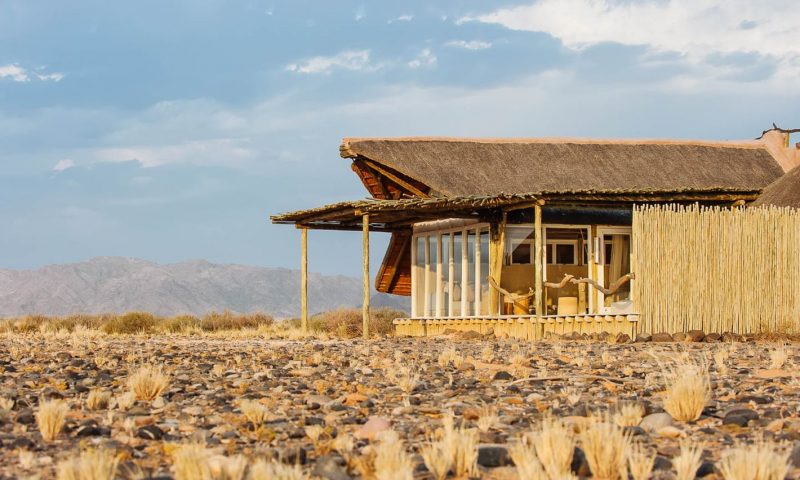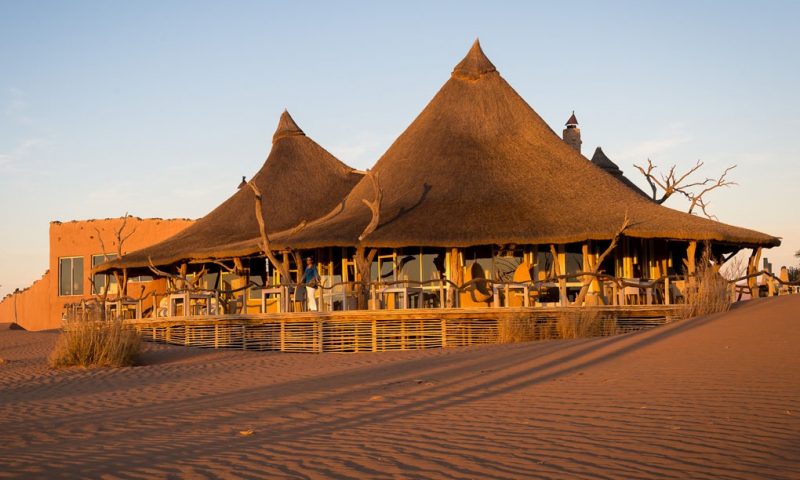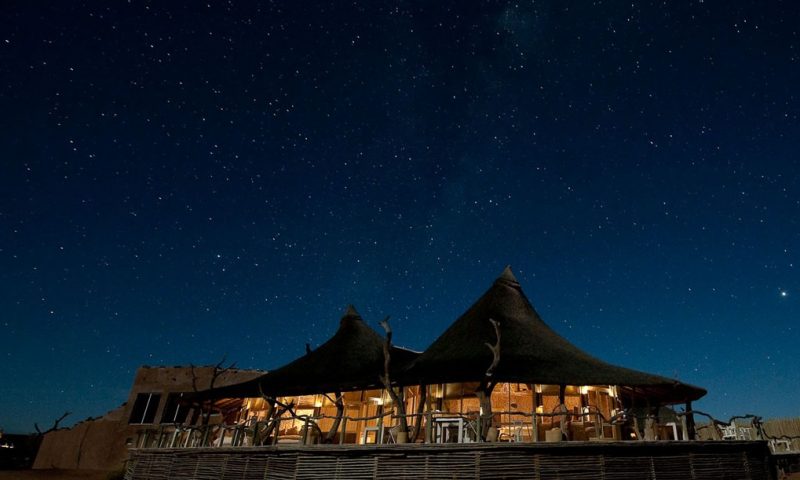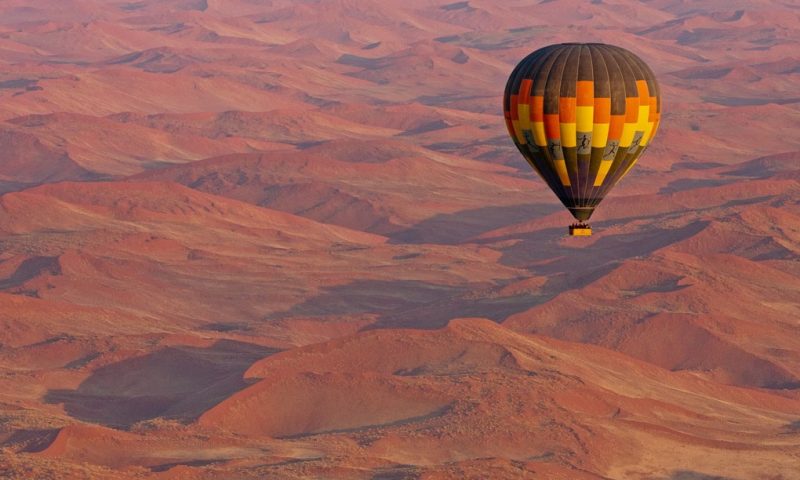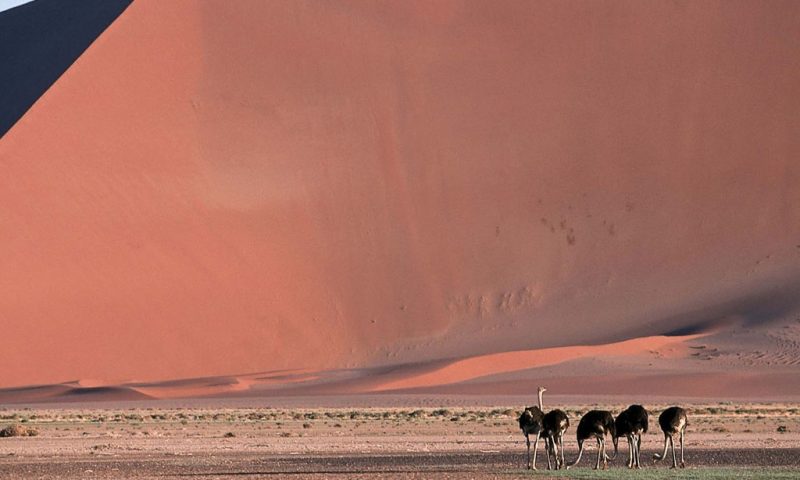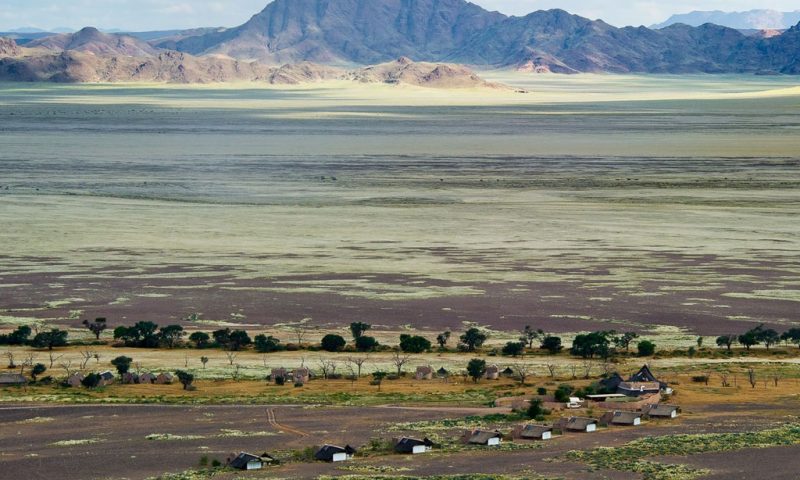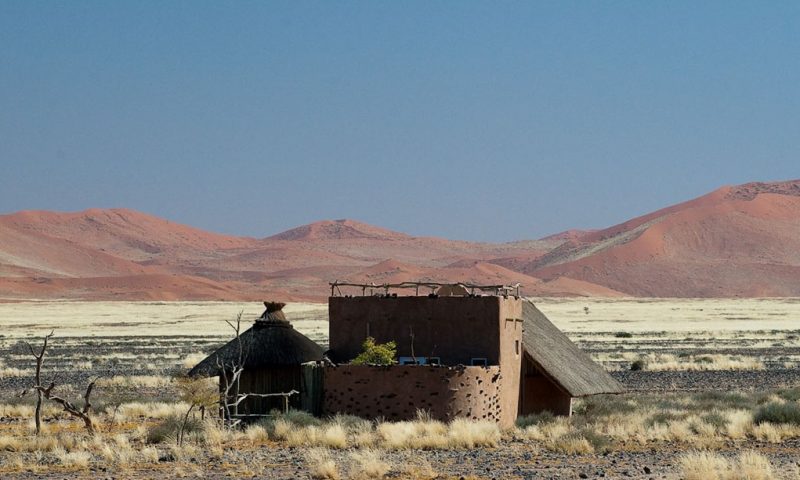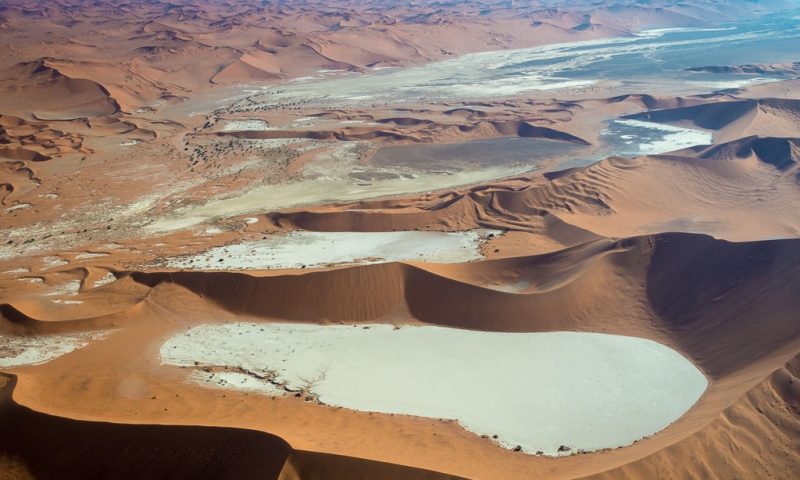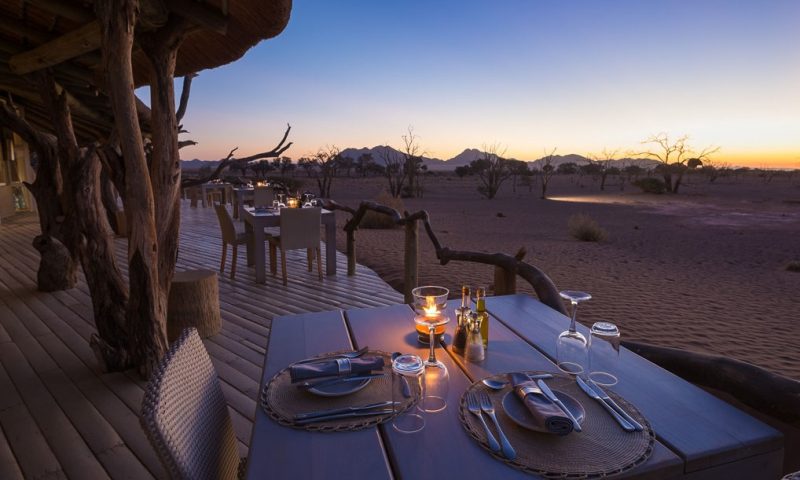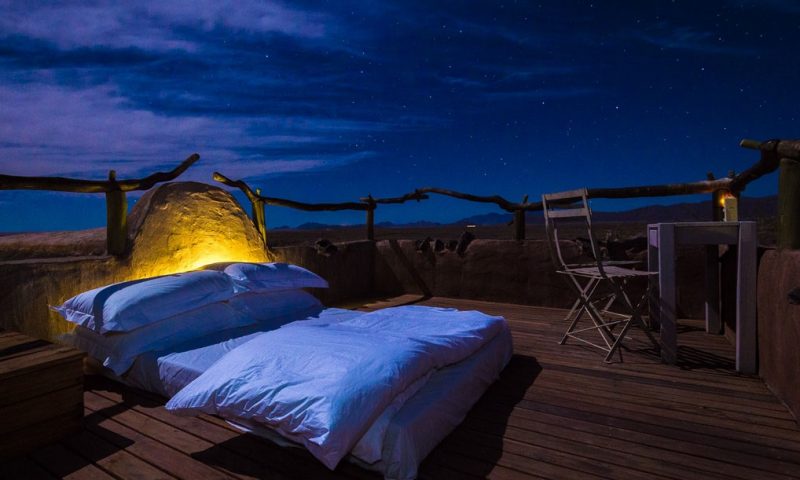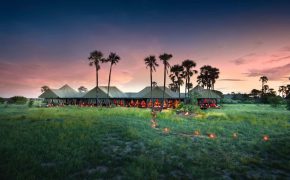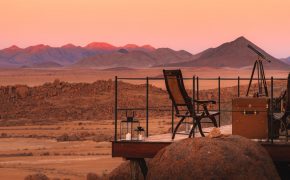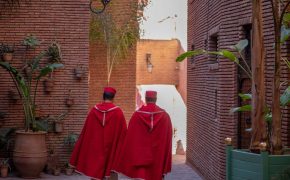Tucked away in the 37 000-hectare private Kulala Wilderness Reserve, Little Kulala treats guests to the unmatched desert luxury. Guests are welcomed to an elegant entertainment area where they can make use of the library, wine cellar and craft boutique, or they can sit back and relax in the lounge.
The expansive Arifican night sky makes dining under the stars a spectacular way to spend your evenings. Taking its inspiration from the surrounding environments, Little Kulala describes itself as an organic camp making use of neutral colours, gorgeous textures and natural light reproduce the soothing pastel tones of the desert.
The interiors are adorned with pure linens, cottons and mohair dyed with natural vegetable dyes, creating a mood of cool serenity. Kulala Wilderness Reserve has its own private gate into the Namib-Nakluft National Park, which makes it the closet camp to Sossusvlei providing guests with splendid views of the red dunes.
ACCOMMODATION
Accommodation is provided by 11 climate-controlled villas, which blend in seamlessly with their surroundings. Each thatched villa has a private bleached deck complete with its own plunge pool. They also each have both indoor and outdoor showers. The interior décor of natural fabrics and textures allow guests to truly experience the serenity of the area.
Guests are invited to take advantage of the night-sky on their own private rooftop “skybed”, where they can indulge in some romantic stargazing and sleep under the stars, should they wish.
ABOUT SOSSUSVLEI
Sossusvlei is a perfect specimen of Nambia’s unspoilt desert beauty. It is a salt and clay pan situated in the largest conservation area in Africa, the Namib-Naukluft National Park. This photogenic area is famous for its large, red sand dunes, which are some of the tallest sand dunes in the world and is one of Namibia’s most visited attractions.
The word Sossusvlei originates from two languages, Nama and Afrikaans. It literally translates to “dead-end” (from the Nama word “Sossus”) “marsh” (from the Afrikaans word “Vlei”).
Strictly, Sossusvlei refers specifically to the salt and clay pan at the end of the Tsauchab River’s course; however, often the entire area including Dune 45, Deadvlei and Hiddenvlei is referred to as Sossusvlei.
At Sossusvlei, the dunes meet preventing the Tsauchab River to flow any further, hence its name meaning “dead-end marsh”. Namibia is very dry and the Tsauchab River seldom flows as far as the pan.
However, following an exceptional rainy season in the Naukluft Mountains the pan is filled and appears as a lake, drawing visitors from all over the world to witness this remarkable site.
The characteristic red dunes of the Namib Desert have developed over many millions of years. The red sand that forms the dunes was deposited into the Atlantic Ocean from the Orange River.
The Benguela current then carried this sand northwards, to be deposited back onto the land by the ocean’s surf. From here the wind carried the red sand inland to form the dunes over time.
The sand dunes in the Namib are dynamic and change shape with the wind. The dunes around the Sossusvlei area are known as “star dunes” due to the wind shaping them from all directions. Enquire now to visit one of Namibia’s most beautiful, natural wonders.
FAUNA & FLORA
It is astounding how the fauna and flora of the Namib Desert have adapted to survive in their extreme environment, with temperatures breaching 40 degrees celius during the day and then plumeting to below freezing at night. This coupled with very little surface water means that a lot happens underneath the sand.
Like the flora in the area, the fauna have evolved incredible characteristics in order to survive in the extreme Namib Desert. The desert is home to countless microorganisms. Beneath the sand live beetles, spiders and reptiles, such as geckos.
All you need to do it look closely at the sand to see countless little tracks from the various interesting animals that have made this Desert their home. Many of these desert-dwelling creatures drink droplets of the occasional fog or lick minute droplets of water trickling down rocks and plants in order to survive. Others extract the moisture from the sand as they burrow through it.
Some of the larger mammals you will see around Sossusvlei are the ostrich, springbok and gemsbok, each well adapted to live in their dry surroundings. Larger predators include spotted hyena and the brown hyena. As the days cool down, you will be able to spot some of the smaller mammals in the cool night air, such as bat-eared fox, black-backed jackal, porcupine, Cape fox and aardwolf.
Camel thorn trees are dotted around the desert, usually along underground water systems. These classically Southern African trees have an impressive tap root system that reaches as far as 60 meters below the sand to access water.
Not only are they able to tap into the underground water systems to allow them to survive the incredibly hot and dry days, they are also adapted to survive frost. It would seem from their name and their usual habitat that they are named for their “camel-like” characteristics.
However this is not the case. The camel thorn tree is actually named after the afrikaans word for giraffe (“kameelperd”) as the giraffe is particually fond of the came thorn’s leaves and the only animal tall enough to reach them.
Another plant you are likely to see close to Sossusvlei are Nara Melons. These round, yellow fruit are approximately 15 centimeters in diameter and are endemic to the region. They also have an impressive root system that reaches down 40 meters in order to access water.
Nara Melons are a tasty treat for the animals in the area, with whom they share a symbiotic relationship – the animals obtain vital fluids and nutrients from the fruit and in turn they spread the seeds in their droppings, ensuring the survival of the plants.
The fascinating Welwitschia plant is found only in the Namib Desert. These plants are sometimes referred to as “living fossils” as the plants that one can see above the ground are thousands of years old. These plants survive by extracting moisture from the air.
ATTRACTIONS IN SOSSUSVLEI
There are a number of wonderful attractions to be enjoyed around Sossusvlei in the largest conservation area in Namibia, the Namib-Nakluft National Park, which covers almost 50,000 km2.
The top attraction of the park and the second most popular attraction in Namibia, Sossusvlei is renowned for its majestic, warm red, star-shaped dunes contrasting against the stark white floors of the pans.
Other attractions in close proximity to Sossusvlei include Sesriem Canyon, Dune 45, Hiddenvlei, Big Daddy and Deadvlei. All of these attractions can be accessed from the road that takes you to Sossusvlei, and are all well worth a visit.
In a number of areas surrounding Sossuvlei look out for the petrified dunes. These are ancient dunes that are approximately 1 billion years old and have solidified into rock.
SESRIEM CANYON
Sesriem Canyon is located approximately 4.5km from the entrance gate of the Namib-Naukluft National Park. The Tsauchab River has shaped the Canyon over millions of years and it is one of the few places in the area that holds water all year round.
The early Afrikaans explorers in the region named the canyon after the fact that they had to use six (“ses”) leather straps (“riem”) tied together to create a rope long enough to lower buckets into the canyon below, in order to fetch water.
There are parking facilities so that visitors can park their vehicles and take a walk through the canyon. The canyon is narrow at places, however it is worth exploring due to the stunning rock formations that will captivate your attention.
DUNE 45
Dune 45 is named for its proximity to Sesrium Gate. It is situated 45km from the gate, along a paved road and is easily reached using a 2×4 vehicle. Its fascinating shape and accessibility makes it the most photographed dune in the world.
The dunes of the Namib Desert were created by sand carried by the wind from the coast of Namibia. The sand here is 5 million years old and is red in colour due to its iron oxide conten. As the lighting changes with the time of day, so does the appearance of the dunes’ characteristic colour, allowing for interesting photographs at any time.
The wind in the Sossusvlei area blows from all directions, which means that the type of the dunes hare are known as “star dunes”. This is because the winds cause the sand to form a star shape with multiple arms. Visitors are allowed to climb Dune 45, so be sure to visit early in the morning to watch the sunrise over the vlei from the top of the Dune.
The Dune is 85 meters high and the climb is well worth the effort as from the top you will be spoilt with the incredible panoramic view of Dune Valley. In the morning and evening light the floor of the pan has been described as a “moonscape” and is truly a sight to behold.
SOLITAIRE
A tiny settlement at the intersection of the C14 and C19, Solitare started as just a single cottage in 1948. Christoffel van Coller and his wife Elsie built the cottage and aptly named it Solitaire due to its remote location.
Over the years a few more facilities were added and today you will find a filling station, a small shop, accommodation and Big Moose’s Bakery. Solitaire is only 83km north of Sesriem Gate and, if only for a taste of Big Moose’s Apple Strudel, is well worth a visit!
Take a seat outside of the bakery, in the shade of the trees and feast on this exquisite treat, while ground squirrels and weavers fight over the crumbs that escape your fork.
HIDDENVLEI
Hiddenvlei is a 2km walk from the end of the 2×4 track and the route is marked with wooden polls. This vlei is the least visited of all the vleis letting those who make the journey enjoy some solitude in the beautiful desert surroundings.
During your walk to Hiddenvlei, look closely at the sand to examine the various tracks of the animals that occupy the area. You should be able to distinguish the tracks of Gemsbok and Springbok quite easily. However, on closer inspection you will be able to see the tracks of the smaller animals that generally live underneath the sand, for example the little Namib Gecko.
BIG DADDY
Big Daddy is the tallest dune in the Sossusvlei area. This magnificent dune is situated between Sossusvlei and Deadvlei and at 325 meters it dwarfs the other dunes. Should you want the ultimate bragging rights, take a lot of water and trek to the top of Big Daddy where you can look down onto Deadvlei.
At 325 meters, Big Daddy may be the highest dune in the Sossusvlei area, however it is not the highest in the Namib Desert. This honour is given to Dune 7, which has been measured at 388m. Dune 7 earned its name by being the 7th dune along the Tsauchab River.
DEADVLEI
Close to Sossusvlei, Deadvlei is a clay pan characterized by dark, dead camel thorn trees contrasted against the white pan floor. The pan was formed when the Tsauchab River flooded and the abundance of water allowed camel thorn trees to grow.
However, the climate changed and the sand dunes encroached on the pan, blocking the river from reaching the area. The trees are estimated to be approximately 900 years old, however they have not decomposed due to the dry climate.
Deadvlei is a paradise for photographers as the contrast between the pitch-black trees and bleached-white pans, and the rusty-red dunes and deep blue sky make for incredible images. Deadvlei is at least 1km walk from the parking lot so be sure to take drinking water with you.
NAMIB SKY BALLOON SAFARIS
Sossusvlei is a photographer’s dream and one of the most fascinating landscapes in the world. Red dunes, dramatic black shadows, rolling plains and rocky-mountains meet here to provide an optical wonderland.
Here, in the Namib Desert (the oldest desert on the planet), landscapes, animals and plants create one of the most incredible eco-systems in the world. The best way to experience the heart of the Namib Desert is in a hot air balloon.
Watch the sunrise over this stunning landscape from the silence of a hot air balloon. This is an experience you are guaranteed never to forget. Namib Sky Balloon Safaris has flown over 55 000 passengers, over 20 years, with a 100% safety record. Your safety is their priority! Namib Sky’s pilots are all highly qualified holders of commercial pilot licenses.
